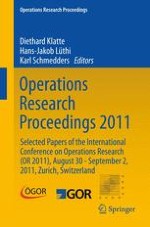This book contains a selection of refereed papers presented at the “International Conference on Operations Research (OR 2011)” which took place at the University of Zurich from August 30 to September 2, 2011. The conference was jointly organized by the German speaking OR societies from Austria (ÖGOR), Germany (GOR) and Switzerland (SVOR) under the patronage of SVOR. More than 840 scientists and students from over 50 countries attended OR 2011 and presented 620 papers in 16 parallel topical streams, as well as special award sessions. The conference was designed according to the understanding of Operations Research as an interdisciplinary science focusing on modeling complex socio-technical systems to gain insight into behavior under interventions by decision makers. Dealing with “organized complexity” lies in the core of OR and designing useful support systems to master the challenge of system management in complex environment is the ultimate goal of our professional societies. To this end, algorithmic techniques and system modeling are two fundamental competences which are also well-balanced in these proceedings.
